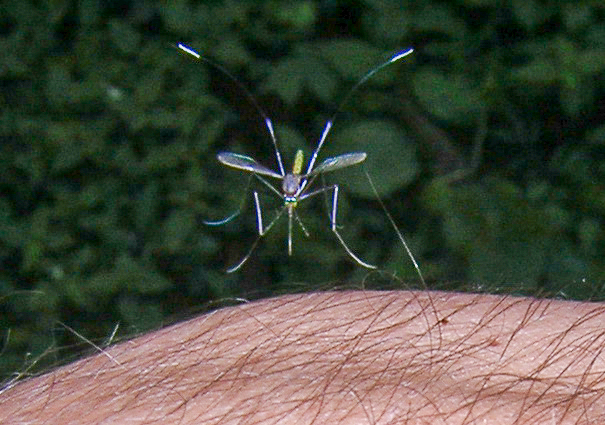The Mosquito Project
Around 20 years ago, in Costa Rica, I shot one of the coolest high-speed photos I’ve ever done, with a point-and-shoot 1.4 MP camera! I was in a forest clearing with lots of mosquitoes, protecting all of my body with clothing, except one arm. With the flash turned on, and focused on my forearm, I allowed mosquitoes to land on my arm, trying to click the shutter at just the right moment. I shook the mosquitoes off my arm after each photo, and repeated this many times until I got the shot that I wanted. I emailed a smaller version of the photo to a friend. Eventually, I upgraded to a camera with more pixels, and forgot about the photo. Only a couple of years ago, I remembered the photo, and I looked everywhere for it, to no avail. I actually think I know where the camera is – inside the wall of my bathroom, where we put a time capsule during a remodel – but the memory card may or may not be in the camera. However, I did find the email version of the photo, just 605 x 425 pixels. This was back in the day of dial up modems, when we tried to keep attachments small.
Anyway, after recalling that photo, I began to think about how to recreate it. Last summer, I put some vegetation in a bucket and left it out in the garden for a few weeks. We don’t have a lot of mosquitoes in the summer in my town, but nevertheless, the few that are around will always find any still water left outside. I let the mosquito larvae grow into pupae, and then separated the pupae into a small container and waited. After some days, the adults began emerging from the pupae. I could tell, because there were empty pupal exoskeletons floating on the surface. On a weekend day, I stayed around the house and checked the container every so often. Eventually, I caught one mosquito in the act of emerging. It’s an amazing, but sort of creepy, thing to watch. It reminds me of how vampires are shown to rise up out of their coffins, except in slow motion. I know that mosquitoes are among the most hated creatures, and rightfully so, but they are also amazingly adapted for their lifestyle. They really are the vampires of the insect world! Last summer, I did not try to get any high speed photos; I just wanted to learn about their emergence behavior. I did try to take some super-slow motion videos of the first flight with my cell phone, but I wasn’t successful. Because the container was outside, even the slightest breeze would move the floating mosquito, triggering the cell phone and/or moving the mosquito out of the field of view.
This past spring, I was ready to try the Mosquito Project for real. I raised larvae just like last summer, and took advantage of a time when my wife was out of town (she would not have been happy to have mosquitoes in the house!). Once the larvae became pupae, I transferred them into a small glass dish in my photo studio and set up all of the camera equipment. I wedged a towel under the door, so the adults would be confined to that one room. With twenty or so pupae in the dish at a time, quite a few adults emerged every day. I spent about a week photographing emerging adults. The emergence only takes a minute or two. After that, the adult waits for around twenty minutes before taking the first flight of its life, but there’s no way to predict exactly when it will take off. Therefore, once an adult emerged, I stayed by the camera and kept the camera shutter open continuously, until the adult flew away. It was painstaking work, but in the end, I got about ten shots of a mosquito beginning the first flight of its life. The two best ones are posted in my insects gallery.
What about recreating the shot of a mosquito landing on my arm? Shockingly, although there were as many as thirty adults in the room at a time, and I spent many hours in their company, none ever tried to bite me!!! I figure that happened because none of the females ever mated. But why would they not mate? Maybe they needed to eat something first. Adult mosquitoes drink flower nectar, so I brought in every type of flower that I could find in my garden. I never saw any of them feeding, and still none went after me. Maybe all of these mosquitoes were hatched from the same egg batch, and therefore were siblings, and they have an instinctual ability to avoid incest. For now, that will remain a bit of a mystery. The next time I try this, I will test the siblings hypothesis by starting two separate batches of larvae, and see if that changes the outcome.

